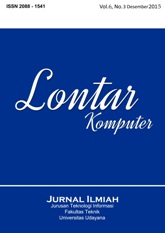Perancangan Sistem Informasi Manajemen Modul Layanan Pada Rumah Sakit
Abstract
Management System Information is one of tools used by organizations or companies to provide information for support several function of operation, management, and problem solver immediately and appropriately. Management System Information is needed by an organization or a large company such as hospital. Management System Information had designed for hospital necessary is formed by several modules in accordance with their respective functions, such as the Service Module. Management System Information of Hospital Service Module is expected to reduce hospital employees for working which several services still going manually paperbased, such as recording a patient's medical record. A method is used for this project called TAS Method who had five stages of design. Design of Management System Information of Hospital Service Module has been connected to six others module through exchanged data between module so that produce a integrated. Some process can be explained from this Service Module is Master Data Management, Treatment, Emergency Unit, Medical support, Medical Record, Scheduling, and Report. The result from designing this system is Exchanged Data Between Module Design, Context Diagram, Data Flow Diagram, Hierarchy Chart, Physical Data Model, and Graphical User Interface.
Downloads
References
[2] H. Mulyanarko, B. E. Purnama, and U. Surakarta, “Pembangunan Sistem Informasi Billing Pada Rumah Sakit Umum Daerah (RSUD) Kabupaten Pacitan Berbasis Web,” Teknologi Informasi dan Komunikasi, 2013.
[3] Y. A. Nugraha Paturusi, I. M. Sukarsa, and I. G. Made Arya, “Hospital Information Sharing based on Social Network Web,” International Journal of Computer Application, 2012.
[4] R. Agusli, M. I. Hanafri, and H. Sari, “Rancang Bangun Sistem Informasi Klinik Menggunakan VB.Net (Studi Kasus: PT. Surya Toto Indonesia),” Sisfotek Glob., pp. 10–17, 2015.
[5] E. Dayanti, “Sistem Informasi Data Kunjungan Pasien Dalam Meningkatkan Pelayanan Kesehatan Masyarakat Pada Pusat Kesehatan Masyarakat (Puskesmas) Munjul Kabupaten Majalengka,” Online ICT STMIK IKMI, pp. 4–14, 2012.
[6] C. A. Fathia, “Sistem Informasi Rekam Medis Sebagai Upaya Untuk Meningkatkan Pelayanan Di Puskesmas Rancaekek,” Unikom, 2010.
[7] Rika and M. Y. Ricky, Analisis dan Perancangan Sistem Informasi Laboratorium Rumah Sakit Kanker Dharmais dengan Menggunakan Metode Total Architecture Synthesis. 2008.
[8] P. C. Brown, Implementing SOA: Total Architecture in Practice. Addison Wesley Proffesional, 2008.
[9] L. F. Wolper and J. J. Pena, Health Care Administration Principles and Practices. Rocksville: Aspen Publishers, Inc, 1987.
[10] E. K. Huffman, Health Information Management. Physicians’ Record Company, 1994.
[11] H. Jogiyanto, Analisis dan Desain Sistem Informasi, 3rd ed. Yogyakarta: ANDI, 2008.
[12] A. Kristanto, Perancangan Sistem Informasi. Yogyakarta: Gava Media, 2008.
[13] Y. Yuliawan, M. J. D. Sunarto, and T. Soebijono, “Pengembangan Sistem Informasi Pendataan Jemaat Gereja Masehi Advent Hari Ketujuh Konferens Jawa Kawasan Timur Berbasis Web,” JSIKA, vol. 2, no. 2, p. 86, 2013.
The Authors submitting a manuscript do so on the understanding that if accepted for publication, the copyright of the article shall be assigned to Jurnal Lontar Komputer as the publisher of the journal. Copyright encompasses exclusive rights to reproduce and deliver the article in all forms and media, as well as translations. The reproduction of any part of this journal (printed or online) will be allowed only with written permission from Jurnal Lontar Komputer. The Editorial Board of Jurnal Lontar Komputer makes every effort to ensure that no wrong or misleading data, opinions, or statements be published in the journal.
 This work is licensed under a Creative Commons Attribution 4.0 International License.
This work is licensed under a Creative Commons Attribution 4.0 International License.























